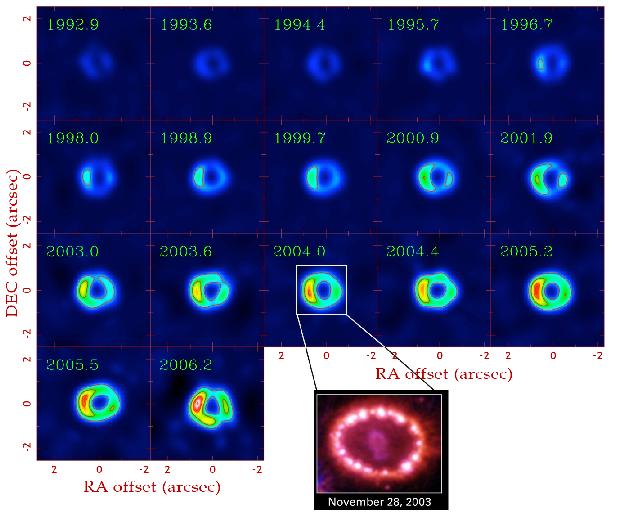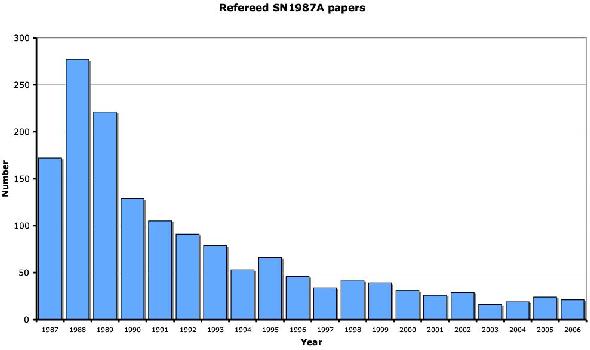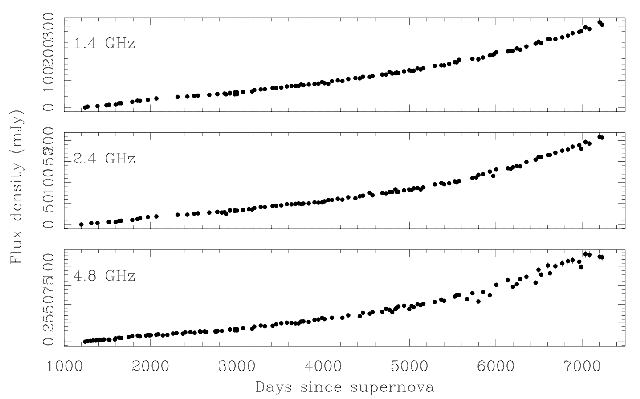Supernova 1987A:
20 years old and still growing stronger!
20 years old and still growing stronger!
The news of a new supernova in the Large Magellanic Cloud quickly swept around the world after its discovery by Canadian astronomer Ian Shelton at Las Campanas Observatory, Chile, on 24 February 1987. A neutrino burst, which signified the event as a type II core-collapse supernova (SN), was retrospectively detected by Kamiokande II and other detectors at UT 07:35 on 23 February.

Figure 1: Compact Array observations of SN1987A at 8 GHz between 1992 and 2006. The images shown have been super-resolved to a resolution of 0.5 arcsec and were taken at multiple frequencies in the 3-cm band and typically include two complementary 6-km configurations. The inset photo is a high-resolution optical image from the Hubble Space Telescope's Advanced Camera for Surveys (ACS), courtesy NASA, P. Challis, R. Kirshner and B. Sugerman (click on image for larger version).

Figure 2: Number of refereed astronomy and physics papers mentioning supernova "1987A" in their title or abstract published each year since 1987. Data from NASA's Astrophysical Data System (click on image for larger version).
The reason for the brightening in the radio and other regimes relates to the extremely high densities in the pre-existing circumstellar medium. This medium is most visible in the Hubble image shown in the inset of the front cover image. Unlike the radio image, the Hubble image mainly shows the pre-existing medium excited by the rapidly engulfing shock wave. However, detailed understanding of the formation of this ring-like structure is still absent, with recent work by Nathan Smith on similar structures around Luminous Blue Variable stars in our own Galaxy calling into question the usual evolutionary scenario which invokes a transition of the progenitor of SN1987A from a red supergiant to a blue supergiant in the recent past.
The unusual brightening of SN1987A and the fact that the radio morphology is no longer due to interaction with an inverse square-law stellar wind, means that it is often regarded as a supernova remnant (SNR) in its early phase, rather than a radio supernova. The gradual flattening of the radio spectral index from an initial value of -1.0 (S∝να) to its current value of -0.7, which is closer to that of canonical SNRs, confirms this.

Figure 3: Seventeen years of Compact Array monitoring of SN1987A up to day 7231
(11 December 2006) showing that the flux density is not only increasing at all
frequencies, but that the rate of change of flux density is also increasing
(click on image for larger version).
Recent observations have resulted in images of even higher resolution compared to the mosaic shown on the front cover (Manchester et al. 2005) and have resulted in the first detection at 3 mm using the upgraded Compact Array. What does the future hold? Low frequency observations with the more sensitive eVLBI array will be useful in establishing the variation of spatial structure across an order of magnitude in frequency, which will help us better understand the acceleration mechanisms. The detection of a pulsar would be extremely important on a number of fronts stellar evolution theories are divided between a neutron star and a black hole end-point for the remnant of SN1987A; and pulsar birth periods currently remain poorly understood. Finally, will SN1987A continue to brighten in the radio regime and perhaps one day rival that of the neighbouring giant HII region, 30 Doradus? Probably unlikely at this stage, but SN1987A has produced many surprises in the last 20 years, and more can be expected!
References
Jauncey, D., et al. 1988, Nature, 334, 412
Manchester, R., et al. 2005, ApJ, 628, L131
Park, S., et al. 2006, ApJ, 646, 1001
Storey, M., Manchester, R. 1987, Nature, 329, 421
Turtle, A. J., et al. 1987, Nature, 327, 38
Lister Staveley-Smith (UWA), Lewis Ball (ATNF), Bryan Gaensler (USyd), Mike Kesteven (ATNF), Dick Manchester (ATNF) and Tasso Tzioumis (ATNF)
(lister.staveley-smith@uwa.edu.au)
